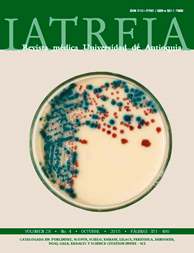Multisystemic tuberculosis: An unusual form of presentation
DOI:
https://doi.org/10.17533/udea.iatreia.v28n4a10Keywords:
children, extrapulmonary, tuberculosisAbstract
Worldwide, tuberculosis is still an important cause of illness and death among children. They are particularly vulnerable to this disease when it is disseminated and severe. The two main risk factors for the progression of the disease are age and the immune status; neonates and infants are most frequently affected. Disseminated disease is often the result of a primary infection in childhood and may be fatal or leave permanent sequelae. Proper treatment improves survival and reduces long-term mortality. Given the importance of this type of tuberculosis in children, and the low index of suspicion, the description of clinical cases is important in order to get a better understanding of its mechanisms. We report the case of a Colombian indigenous infant with an extensive tuberculosis; risk factors and clinical manifestations of disseminated tuberculosis in this population are discussed.
Downloads
References
(1.) Smith BB, Hazelton BJ, Heywood AE, Snelling TL, Peacock KM, Macartney KK. Disseminated tuberculosis and tuberculous meningitis in Australian-born children; case reports and review of current epidemiology and management. J Paediatr Child Health. 2013 Mar;49(3):E246-50. DOI 10.1111/jpc.12035.
(2.) World Health Organization. Global tuberculosis report 2012 [Internet]. Chapter 1. Geneva: WHO; 2012. [Cited 2014.12.02]. Available from: http://apps.who.int/iris/bitstream/10665/75938/1/9789241564502_eng.pdf
(3.) World Health Organization. Global tuberculosis control : epidemiology, strategy, financing [Internet]. Chapter 1. Geneva: WHO; 2009. [Cited 2014.12.05]. Available from: http://goo.gl/jXXPMK
(4.) Marais BJ, Gie RP, Schaaf HS, Beyers N, Donald PR, Starke JR. Childhood pulmonary tuberculosis: old wisdom and new challenges. Am J Respir Crit Care Med. 2006 May;173(10):1078-90.
(5.) Sharma SK, Mohan A, Sharma A, Mitra DK. Miliary tuberculosis: new insights into an old disease. Lancet Infect Dis. 2005 Jul;5(7):415-30.
(6.) Starke J. Tuberculosis. In: Jenson HB, Baltimore RS, editors. Pediatric infectious diseases: principles and practices. 2a ed. Philadelphia: Saunders; 2002. p. 396-419.
(7.) Cruz AT, Starke JR. Clinical manifestations of tuberculosis in children. Paediatr Respir Rev. 2007 Jun;8(2):107-17.
(8.) Myers JN. Miliary, central nervous system, and genitourinary tuberculosis. Dis Mon. 2007 Jan;53(1):22-31.
(9.) Marais BJ, Gie RP, Schaaf HS, Hesseling AC, Obihara CC, Starke JJ, et al. The natural history of childhood intra-thoracic tuberculosis: a critical review of literature from the pre-chemotherapy era. Int J Tuberc Lung Dis. 2004 Apr;8(4):392-402.
(10.) Newton SM, Brent AJ, Anderson S, Whittaker E, Kampmann B. Paediatric tuberculosis. Lancet Infect Dis. 2008 Aug;8(8):498-510. DOI 10.1016/S1473-3099(08)70182-8.
(11.) Upham JW, Rate A, Rowe J, Kusel M, Sly PD, Holt PG. Dendritic cell immaturity during infancy restricts the capacity to express vaccine-specific T-cell memory. Infect Immun. 2006 Feb;74(2):1106-12.
(12.) Upham JW, Lee PT, Holt BJ, Heaton T, Prescott SL, Sharp MJ, et al. Development of interleukin-12-producing capacity throughout childhood. Infect Immun. 2002 Dec;70(12):6583-8.
(13.) Goriely S, Vincart B, Stordeur P, Vekemans J, Willems F, Goldman M, et al. Deficient IL-12(p35) gene expression by dendritic cells derived from neonatal monocytes. J Immunol. 2001 Feb;166(3):2141-6.
(14.) White GP, Watt PM, Holt BJ, Holt PG. Differential patterns of methylation of the IFN-gamma promoter at CpG and non-CpG sites underlie differences in IFN-gamma gene expression between human neonatal and adult CD45RO- T cells. J Immunol. 2002 Mar;168(6):2820-7.
(15.) Kampmann B, Hemingway C, Stephens A, Davidson R, Goodsall A, Anderson S, et al. Acquired predisposition to mycobacterial disease due to autoantibodies to IFN-gamma. J Clin Invest. 2005 Sep;115(9):2480-8.
(16.) Restrepo A, Trujillo M, Garcés C. Tuberculosis. En: Correa JA, Gómez JF, Posada R, editores. Fundamentos de pediatría: Infectología y neumología. 4th ed. Vol. 3. Medellín: CIB; 2013. p. 247-62.
(17.) Calle M. Tuberculosis en niños. En: Reyes MA, Aristizábal Duque G, Leal Quevedo J. Neumología pediátrica. 5a ed. Bogotá: Panamericana; 2006. p. 304-14.
(18.) Moreno-Pérez D, Andrés Matín A, Altet Gómez N, Baquero-Artigao F, Escribano Montaner A, Gómez-Pastrana Durán D, et al. Diagnóstico de la tuberculosis en la edad paediátrica. Documento de consenso de la Sociedad Española de Infectología Pediátrica (SEIP) y la Sociedad Española de Neumología Pediátrica (SENP). An Pediatr (Barc). 2010 Sep;73(3):143.e1-43.e14. DOI 10.1016/j.anpe-di.2009.12.017.
(19.) Pérez-Vélez CM. Pediatric tuberculosis: new guidelines and recommendations. Curr Opin Pediatr. 2012 Jun;24(3):319-28. DOI 10.1097/MOP. 0b013e32835357c3.
(20.) World Health Organization. Treatment of Tuberculosis Guidelines. 4th ed. [Internet]. Chapter 8, pag 95-98. Geneva: WHO; 2010. [Cited 2014.12.05]. Available from: http://apps.who.int/iris/bitstream/10665/44165/1/9789241547833_eng.pdf?ua=1&ua=1
Downloads
Published
How to Cite
Issue
Section
License
Copyright (c) 2015 Iatreia

This work is licensed under a Creative Commons Attribution-ShareAlike 4.0 International License.
Papers published in the journal are available for use under the Creative Commons license, specifically Attribution-NonCommercial-ShareAlike 4.0 International.
The papers must be unpublished and sent exclusively to the Journal Iatreia; the author uploading the contribution is required to submit two fully completed formats: article submission and authorship responsibility.














